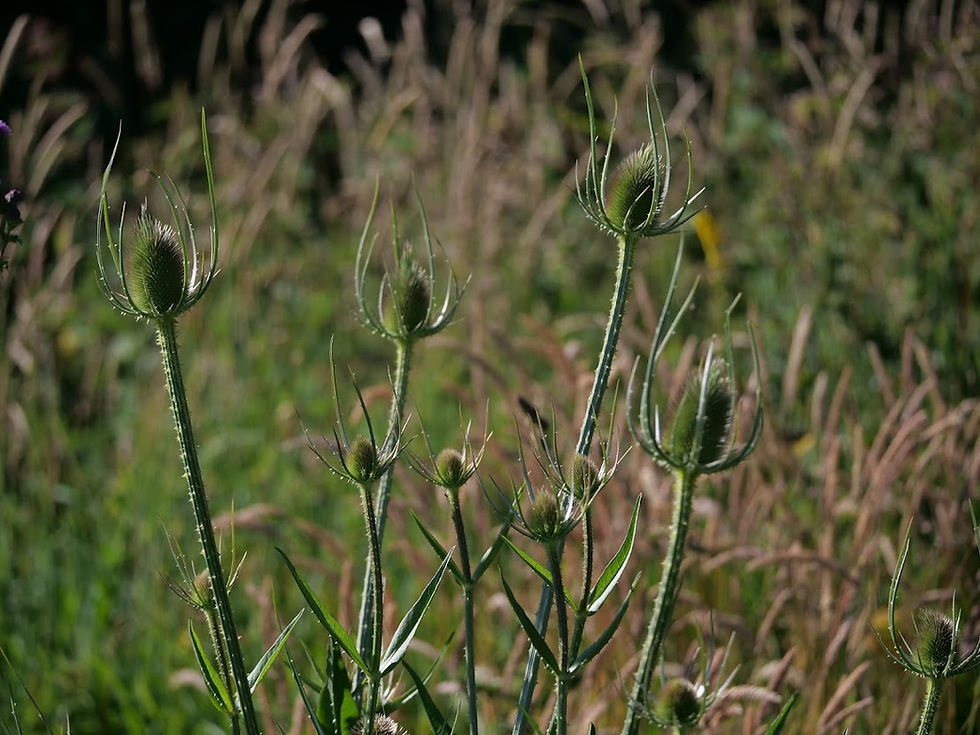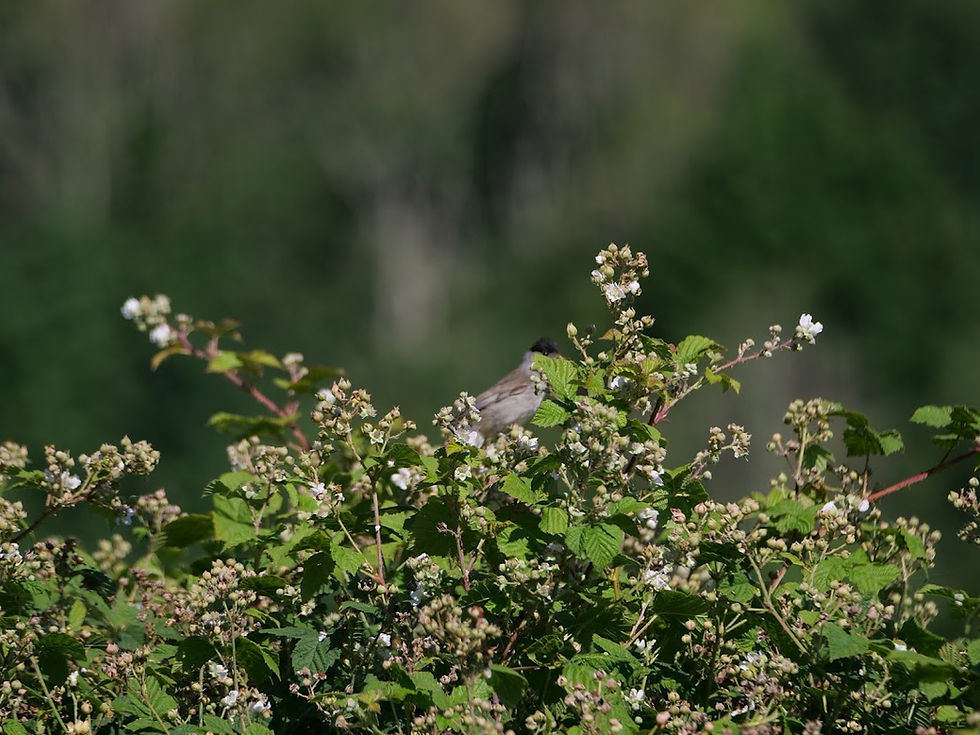Steyning Downland Scheme: a Marsh Tit, a Dingy Skipper and a Grey Wagtail. 05.07.22
- Sim Elliott
- Jul 5, 2022
- 5 min read
Updated: Aug 5, 2022
I had wanted to visit the Steyning Downland Scheme for some time; and it was easy to reach by bus number 2 from Brighton (an hourly service, and an hour trip from central Brighton to Steyning). The focus of my visit was Butterflies. I saw an abundance of common butterflies (Ringlets, Gatekeepers, Meadow Browns, Marbled Whites, Small Heaths, Small Skippers) and I also saw a Dingy Skipper, quite a late sighting in Sussex. I also saw two rarer birds - a March Tit and a Grey Wagtail. I shall be visiting again in August, to try and see Brown Hairstreaks.
All sections of text in this post in italics are quotations, and their sources are given. The photographs are presented in the chronological order of my visit.
The SDS {Steyning Downland Scheme] site is made up of open grassland, a stream, ponds and mixed woodland. Since 2007 more and more people of all ages have got involved on the site through one of the many activities taking places. Activities include practical conservation work, survey work, bushcraft, nature walks and much more! Steyning Downland Scheme | Facebook
But perhaps our claim to fame is being the best site in the UK to see the Brown Hairstreak. Its foodplants are shrubs of the genus Prunus, chiefly Blackthorn (Prunus spinosa), a common hedgerow plant. Our team of Conservation Volunteers manage our clumps of Blackthorn specially for the butterfly. In late summer we are visited by butterfly enthusiasts from across southern England and beyond, hoping to see this elusive butterfly Butterfly Surveyors | Steyning Downland Scheme
How to get to the reserve
From the number 2 bus stop, walk north along the Hight Street and turn left onto Sir George's Place

then turn left along the footpath, at the end of the footpath turn right into Charlton Street, at the junction of Charlton Street and Mill Road turn up the track (Allotments Lane) that goes up to the "Riffle Range" and Steyning Coombe


As I walked along the track (Allotment Lane) to the reserve, I saw this Gatekeeper; I have only seen Gatekeepers over the last few days as they have only just emerged.



Allotment Lane

Riffle Range
Meadow Brown

Ringlet


Ringlet

Spear Thistle

Teasel

Meadow Brown

Path on the right (south) of the former Riffle Range

Meadow Brown flying to a Yellow Ragwort

Male Marbled White on Red Clover

Small Skipper on White Clover

Male Marbled White on Red Clover

Male Meadow Brown

Male Marbled White on Spear Thistle

Male Meadow Brown

Sycamore seedling and big bramble bush; the scene for Blackcap's Big Breakfast Insect Buffet on Bramble.

A Meadow Brown on the bramble

Blackcap. I was mesmerised by this blackcap perched on the sycamore sapling, repeatedly flying into a bramble bush, then going back to his sycamore branch, then going back into the bramble. Then I realised it was flying into the bramble, taking an insect, flying back to the Sycamore, eating it, and then flying back for another insect. The bramble was heaving with butterflies, moths, hoverflies, other flies, beetles, and bumblebees.



Common Carpet Moth in the bramble bush

A ringlet

The bottom of the "Riffle Range! The clump of trees is where the spring emerges from the downs.
The "landscape of rolling hills and valleys is underpinned by its geology. Thin soils and unimproved flower rich grassland overlay white porous chalk (limestone) made up of dead marine animals laid down over millions of years. This porous rock holds much of the drinking water the people of Sussex rely on. Clean chalk springs surge from the base of its scarp slopes, such as the one found at Fulking and Edburton. These springs fed streams meander through the landscape supporting an unusual diversity of wildlife including important fish populations and many specialist insect species. An iconic landscape of Sussex and Hampshire this linear feature is made up of closely cropped grassland, arable fields and steeply growing “Hanger woods”. Downland | Sussex Wildlife Trust


Iris

Steyning Coombe

Meadow Brown

Marbled White

Pyramid Orchid

Truleigh Hill, in the distance

Female Meadow Brown

Dingy Skipper

Found in Britain and Ireland but becoming increasingly rare. Grey-brown wings with mottled brown markings and two rows of small white spots. A small butterfly with a low, darting flight. Grizzled Skipper is similar in size but has brighter black and white markings.
In the sunshine, the Dingy Skipper often basks on bare ground with wings spread wide. In dull weather, and at night, it perches on the tops of dead flowerheads in a moth-like fashion with wings curved in a position not seen in any other British butterfly. This small brown and grey butterfly is extremely well camouflaged. It may be confused with the Grizzled Skipper, the Mother Shipton moth and Burnet Companion moth, which sometimes occur on the same sites at the same time.
The Dingy Skipper is locally distributed throughout Britain and Ireland but has declined seriously in recent year. Dingy Skipper | Butterfly Conservation (butterfly-conservation.org)

In Sussex July is past the peak for recorded sightings of Dingy Skipper, so I was surprised to see this individual. The last time I had seen a Dingy Skipper was sex weeks ago.

Wild flowers of Steyning Coombe

Horseshoe Woods

Trees to the north of Steyning Coombe

A bird leaving its log perch - possibly a ChiffChaff

View toward the scarp face of the South Downs on the other side of the Adur River

Truleigh Hill and Ditchling Beacon

Six-Spot Burnet Moth

Wild Thyme

Gatekeeper

Horseshoe Woods

Marsh Tit

Sadly the Marsh Tit is greatly in decline: Marsh Tit abundance has declined almost continuously since BTO monitoring began. Because of worsening decline, the species' UK conservation listing was upgraded from amber to red in 2002. Atlas surveys during 2007-11 showed continuing loss of breeding and winter range since 1968-72, especially in northern England and the north Midlands (Balmer et al. 2013). Conservationists are keen to prevent Marsh Tit replicating the deeper decline and regional range losses shown already by Willow Tit, and are focusing on providing more mature woodland and promoting woodland connectivity (Broughton & Hinsley 2015). Species | BTO - British Trust for Ornithology
Walk through the woods



A juvenile Robin

Riffle Range
Meadow Brown on Knapweed

Small Skipper on Red Clover

End of the Rifle Range and Horseshoe Woods

Gatekeeper on marjoram

Marbled White on Field Scabious

Riffle Range - clump of trees at bottom is where the spring emerges

Machinery and buildings of the Rifle Range targets






The target machinery and buildings are hidden from view, as they are behind the grass bank as you look up the Riffle Range

Meadow Brown on Yellow Ragwort

Female Blackbird seemingly eating a crab apple.

Information in the history of the Steyning Rifle Range


A Community Orchard within the scheme

A Grey Wagtail in the stream that flows from the Spring



A Dragonfly (not possible to identify)


The pool in the stream from the spring


(Hart's Tongue?) Fern on wall at bottom of pool


Path beside the trees that follows the stream from the spring

Marmalade Hoverfly nectaring on Field Groundweed


A pair Small Heaths aerial dancing (pair bonding?)


St Andrew and St Cuthman Church

The chancel arch of c1100 is the oldest remaining part of a once cruciform church, begun around 1080. Four bays of the nave of c1160-80 are the main survival, with work of a high order. The tower is later C16. A small probably C18 chancel was altered in the C19. Steyning – St Andrew and St Cuthman – Sussex Parish Churches


The Brotherhood Hall was originally the Guild Hall of the Fraternity of the Holy Trinity. ... At the Dissolution of the Monasteries all the Brotherhood property was appropriated by King Henry VIII ... Its use as a school for little boys can be traced back to 1584. A timber-framed I5th century construction, it has been extensively altered over the years, extended and made safe. ,,, In 1906 the school came under the wing of West Sussex County Education Committee and new classrooms were built in 1912*, with further additions in 1933. Modern developments and alterations were carried out after the Second World War in the 1950s and 1960s to provide a new boarding house, dining room and up-to-date science laboratories. The school amalgamated with Steyning Secondary Modern School in 1968 and after a few years the Church Street site became the Lower School, a further massive rebuilding programme providing facilities for the 11 to 13 year-old age groups. Brotherhood Hall (steyningmuseum.org.uk)
One of Steyning's older houses


Comments